July 2013 Archives
The latest currency determination for the Royal Australian Mint has passed through parliament and gives us a sneak peak into what the upcoming releases of new legal tender coins will be. It doesn't mean the Mint will have to make these coins but it certainly tells us they might be. Here it is in a nutshell.
1. The 2014 Mint and Proof Sets look to carry a coloured and gold plated coin as they have done for the last 2 years. Next year (2014) we should see the mob of roos design 1 dollar as a gold plated coin in the proof set and as the coloured coin in the mint set. Of the 5 kangaroos in the design, just 3 of them will appear coloured or gold plated. It's also suggested the one dollar will be minted in copper nickel (cupro-nickel like a 10 cent coin) and not the copper-aluminium-nickel (aluminium bronze) we usually see this design struck in. Obviously gold plating wouldn't stand out on an already gold looking planchet so a different planchet composition is needed. This might be a show-stopper!
2. Later this year we'll see a second coin for the Australian Football League (AFL) Premiers with all teams included in the currency determination but as with 2012 only the winning team coin is likely to be struck. Again there will be the two very similar 1 dollar coins produced the same design as the 2012 coins but dated 2013.
3. The famed Australian racehorse Black Caviar has been so popular who could resist minting Tony Deans 1 ounce silver one dollar design in pure gold. This design struck on a planchet of half an ounce of gold will look stunning with a $50 legal tender value.
4. The Sydney Opera House will record it's 40th Anniversary on October 20th 2013 so a commemorative 1 dollar coin for this occasion is in the pipeline. The Opera House was inscribed onto the World Heritage Sites list in 2007 by UNESCO and is an iconic form in the Sydney skyline and is an architectural masterpiece.
5. We'll see another round of coloured pad printed one dollar coin following this years Polar Animals series. The first two coins will depict a gorgeous Ulysses Butterfly and a Blow Fly complete with eggs, larvae and pupae (someone has to say it, yes sounds like maggots).
6. The mintmark, privymark and counterstamp 1 dollar design for 2014 will commemorate 200 years since "A Voyage to Terra Australis". Exploration of the great unknown southern continent was conducted by Matthew Finders from 1801-1810 who proved that Australia was a single land mass when he succeeded in circumnavigating the continent. A book of the same title was published in 1814 by Flinders. The coin design will depict Flinders' ship, the HMS Investigator, a representation of a compass and part of the map of Australia.
7. Military themes on coins are always popular with collectors and upcoming releases will be of interest. 100 years of ANZAC will appear on a 2014 dated aluminium bronze 1 dollar and we'll be celebrating this until 2018 so we're sure there'll be many more ANZAC themed releases of this kind over the next few years. Those who served in the Boer War from 1899 to 1902 will be remembered with a coloured 50 cent coin depicting a statue of a soldier riding a horse and the colours of the medals awarded to soldiers for their service in South Africa.
We've only touched on the more important parts of the currency determination. I guess we'll stay tuned for more news of how and when these coins will appear for collectors.
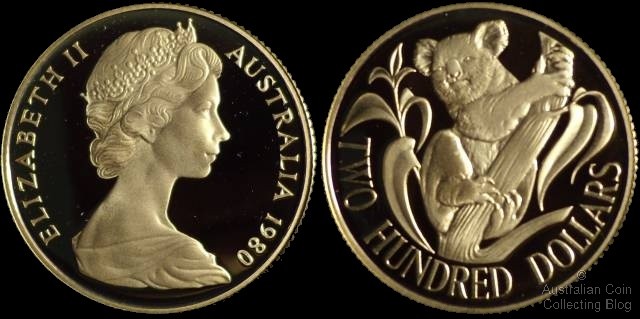
Australia 1980 Two Hundred Dollar $200 Gold Koala Coin, a popular example
Koalas are not springy like Kangaroos, they tend to while the days away dozing in the fork of a tree becoming active in the night time eating gum leaves and living in the forks of branches in those eucalyptus trees. Commonly called the Koala Bear (particularly by the early settlers) they are not in fact bears but their name is derived from an aboriginal word meaning no water. Koalas don't often drink water as their eucalyptus leaf diet contains all the moisture they need to survive.
There are parts if Australia where you can find Koalas living in the wild without having to view them captive in zoos and wildlife parks. Wandering through Adelaide suburbs along bike paths and walking tracks you might look up and see a Koala -and you're in the city! They may appear cute but can be aggressive if approached so keep your distance.
Koalas have long appealed to tourists visiting Australia so you can see why the Mints are keen to depict the Australian Koala on a coin. The Royal Australian Mint shop in Canberra does a thriving trade of Koala related coin sales when busloads of tourists visit our coin producing factory in Deakin.
Here are some of the coins Australia has minted with Koala designs, if the Koala was a Chinese sign of the Zodiac then there would surely be even more Koala coins issued!
From our circulating coin producer the Royal Australian Mint:
2004 Student Design 50 cent is the only Koala you'll find in circulation, a design with other native animals
2009/10 Dorothy Wall 1 Dollar featuring Blinky Bill an illustrated character by Dorothy Wall
2009 Steve Irwin 1 Dollar also features a Koala
2008 Land Series Coloured Koala
1980-1986 Koala $200 Machin and Maklouf obverse (the 1980 Koala reverse with the Machin obverse seen above)
2008 5 Dollar Little Dinkums Cartoon Koala 1/25 oz Fine Gold Proof coin
From the Perth Mint:
2011 Bush Babies 1 Dollar Koala Silver Proof and PNC
2000 Olympic Issue 5 Dollar Koala and Flowering Gum Fine Silver Proof
2006 and 2010 Discover Australia Platinum, Silver and Gold Proof issues
2007-2011 Silver, Gold and Gilded Specimen, Proof and Piedfort (2009 Silver Specimen seen below)
1988-2005 Platinum Proof and Specimen
2013 1oz SIlver Coloured Coin in card
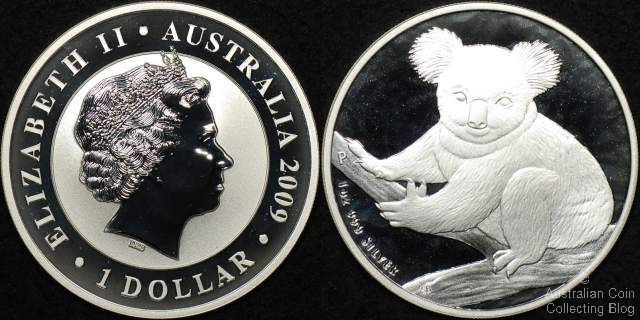
Australia 2009 1 Dollar Silver Koala Coin
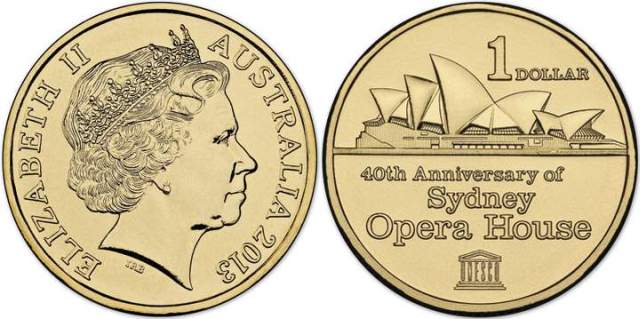
Australia 2013 40th Anniversary of the Sydney Opera House 1 Dollar (image courtesy www.ramint.gov.au)
The 20th October 2013 marks the 40th Anniversary since the opening of the Sydney Opera House, an iconic building that sets apart the Sydney skyline from anywhere else in the world. The Sydney Opera House sits on Bennelong Point, a rock arm on the eastern end of Sydney Cove, Australia. To mark this occasion a special 1 dollar coin will be minted and is set to be released on September 2nd.
From the 1940's a need was seen for a theatrical venue in Sydney and in 1955 an international design competition was held to design the Sydney Opera House. Of 233 entries from 32 countries Danish architect J??rn Utzon was the winner announced in 1957 and he was awarded prize money of 5,000 pounds. This great artistic monument is constructed of huge pre-cast concrete shells the "design inspired by the simple act of peeling an orange" he said, the shells if formed together would produce a complete sphere.
It took 14 years to build with many architectural hurdles to overcome. This was almost 6 years longer than originally expected and ten times more than its original estimated cost. Such a large project was always going to have problems in construction and complexities and disagreements forced Utzon to resign from the project entirely and he didn't attend the opening nor was his name mentioned at the event. It was opened on 20 October 1973 by Queen Elizabeth II on a special royal visit for the occasion. It wasn't until the late 1990's that the trust began a reconciliation with Utzon and in 2007 a space was rebuilt and named the Utzon Room. He died in 2008.
In June 2007 the Sydney Opera House was inscribed onto UNESCO's World Heritage Sites list to protect and preserve this great urban sculpture as one of the greatest architectural works of the 20th century. UNESCO (United Nations Educational, Scientific and Cultural Organization) will ensure over time it is protected and preserved for it's cultural and iconic value to society so it may be appreciated by many more generations.
Today there are over 40 shows each week held at the Sydney Opera house showcasing not just Opera (in the Joan Sutherland theatre) but Ballet, Symphony and Orchestral masterpieces along with hosting all sorts of events and performances. More than seven million people visit each year just to marvel at it's design.
This October on the 40th birthday of the Opera House the historic significance of the building with a special commemorative one dollar coin struck by the Royal Australian Mint, the reverse design with those iconic vaulted sails by the Mints' own Aleksandra Stokic. Each coin is struck in uncirculated quality on an aluminium bronze 9 gram planchet. The 25 millimetre $1 is housed in a capsule in a collector card and is issued for $13.50. Mintage of this coin is unlimited at this time. This design is also being struck in a 1 ounce fine silver proof with a mintage of 5,000 coins.
The Sydney Opera House has been seen before on legal tender coins the most memorable a 1997 10 dollar coin and in 2006 a 1/25 oz 5 dollar gold proof from the Perth Mint.
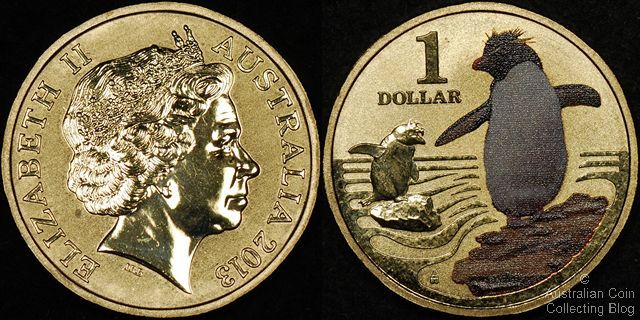
Australia 2013 Rockhopper Penguin Coloured 1 Dollar
The second coloured 1 dollar coin in the very popular Polar Animals 6 coin series features a reverse of the Rockhopper Penguin and is issued by the Royal Australian Mint.
If you've seen Happy Feet 2, you'll be very familiar with Lovelace, the Rockhopper Penguin - a very laid-back, overweight, larger than life flamboyant character, with smokey blues-jazz vocals and so much charm. His distinguishing accessory is the plastic "6 pack" collar around his neck, which he's unaware is slowly strangling him. The core message of this film focuses on pollution, global warming and what we can do collectively to make our environment a better place to live in.
With this in mind, you might not be very surprised to learn that the Rockhopper Penguin population is in rapid decline due to pollution, global warming and commercial overfishing. They'll certainly be placed on the endangered list in the very near future if their numbers don't increase.
Another factor contributing to their declining numbers is that the majority of the breeding season's first laid eggs usually don't hatch after incubation, with those chicks that do hatch invariably dying within a few days of hatching - eaten by artic birds such as skuas, petrels and Dominican gulls. Other predators of the Rockhopper Penguins are Blue sharks, leopard and fur seals.
Despite the larger than life character portrayed in Happy Feet 2, you also might be surprised to learn that the Rockhopper Penguin is the world's smallest penguin, only around 50 centimeters tall, although very similar in appearance to most penguins - they have a large head, short thick neck, short wedge-shaped tail, little flipper-like wings and webbed feet. And like all penguins, their body colouring is "countershaded" which means they have a lighter colour on their belly and a darker colour on their back, camouflaging them from their predators when they're in the ocean.
However, there's absolutely no mistaking their very distinctive features of bright orange-red bill and yellow feather plumes fanning out and framing their bright red eyes.
As their name suggests, Rockhopper Penguins live amongst clumps of grasses called tussocks, as well as in small caves and crevices, and on rocky slopes. And it's in this pose hopping around on the rocks that designer Aaron Baggio portrays two Rockhopper Penguins on a reverse with a frosted uncirculated finish. The design is struck on a 9 gram aluminium bronze planchet and is a standard 25 millimetre 1 dollar coin with the obverse portrait of Queen Elizabeth II by Ian Rank-Broadley.
As mentioned earlier, this coin is the second of six NCLT (non-circulating legal tender) coins in this series -others in this Polar Series are the Polar Bear dollar, Humpback Whale dollar, Walrus 1 dollar and the Weddell Seal dollar. This coloured series follows the popular Animals of the Zoo Series of 2012, the Air Series of 2011, Land Series 2008-9 and 2006-7 coloured Ocean series.
The Rockhopper Penguin coin retails at $15 and is presented in a colourful collector's card. Mintage is unlimited at this time and will be determined by collector demand. See the 2013 issues and mintages table for the most up to date information.
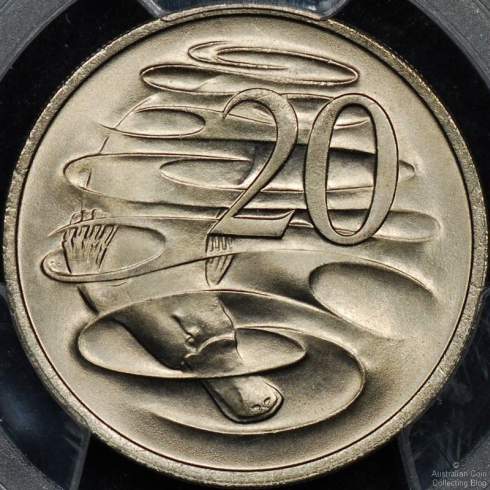
Platypus 20 Cent Coin Reverse (1972)
The Australian 20 cent coin has been minted since 1966 to the present day and is highly collected and loved. It has been released with many commemorative designs both for circulation and for the collector market. The swimming platypus reverse is the standard iconic design by Stuart Devlin.
The twenty cent is 28.52 millimetres in diameter and is struck on a round shaped copper-nickel planchet of 75% copper and 25% nickel. It has edge reeding or milling and weighs 11.31 grams, the same size and weight as a pre-decimal florin.
The standard reverse or tails side of the Australian 20 cent is the design of a swimming platypus by coin designer, sculptor and master silversmith Stuart Devlin. Of all the standard Australian circulating coin designs that Mr Devlin engraved this platypus is his favourite. There is a perception of depth in the design that he sought to capture with this coin winning the hearts of a nation. It is one of the most highly collected denominations.
Stuart Devlin now lives in England but in 1963 resided in Melbourne where he entered a competition to design the new decimal coins for the changeover to decimal currency in 1966. The decimal 20 cent would replace the silver one florin in the old money. The twenty cent platypus design carries Mr Devlins SD initials next to the to the claw at approximately 9pm.
The platypus design was not issued for circulation every year so some dates must be obtained from Mint Sets. Almost all the coins have been minted at the Royal Australian Mint in Canberra although in 1966 some coins were struck in London and in 1981 Wales and Canada. The Canadian coins having a distinctive missing claw (or 3.5 claws) mintmark/variety. One particular die that struck coins in London in 1966 had a wave on the top of the baseline of the 2 and is called the Wavy 2 or Wavy 20 variety, these coins can be found in your change and can be worth hundreds of dollars.
Many commemorative 20 cent coins have been struck for both circulation and collectors. It's always a surprise to get something different in your change and discover what event or milestone Australia celebrates. We began to issue commemorative 20 cent coins in 1995 with the 50th anniversary of the United Nations and then the Sir Donald Bradman tribute coin in 2001. Following this a barrage of commemorative coins entered circulation and many more were minted for collectors called NCLT that were released in special packaging but were not intended to circulate. The list of commemorative coins you could find in your change (at this time) is almost 20 different coins!
Every coin features the denomination on the reverse and the obverse has seen three different portraits of Queen Elizabeth II. From 1966 to 1984 the twenty cent was minted with the Arnold Machin portrait of the young Queen. From 1985-1998 it was struck with the Raphael Maklouf portrait and today (from 1999 to the present) we see the mature depiction of QEII by Ian Rank-Broadley.
Slight variations in the obverse design can be found with the Mint trialing newer technology resulting in 2004 a large head and small head Queen obverse and differences in the font of the IRB initials of designer Ian Rank-Broadley. In 2013 the Mint struck the platypus 20 cent piece in their 6 coin uncirculated set in hyper-metallic colour!
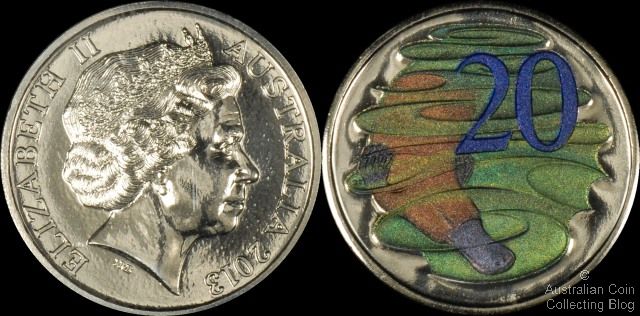
The Australian 20 cent platypus in colour!
Error 20 cent coins can show up from time to time and can be very spectacular. Of particular rarity are the platypus 20 cent being struck on a Hong Kong $2 scallop shaped planchet of which only a handful are known and also the platypus design struck on a bi-metal planchet is sure to stick out and be noticed as something unusual! These are however coins made in error where wrong planchets have been mixed up in the barrels of blanks and can fetch thousands of dollars on the collector market. Other known 20 cent error coins are more commonly found but still keenly sought the partial collar error, clipped planchet error, split planchet error and lamination flaws.
To date over 1.8 billion uncirculated 20 cent coins have been minted to be carried around in Australian pockets! Check out the mintages in our handy online tool Australian Coin Mintages. This tool is a work in progress so please excuse it's incompleteness.
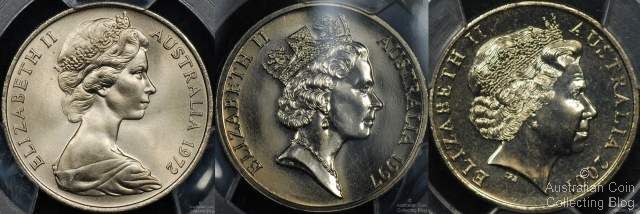
Platypus 20 Cent Coin Obverses from left Machin, Maklouf and Rank-Broadley portraits of Queen Elizabeth II
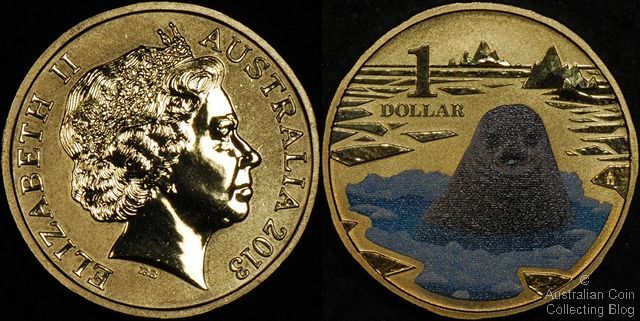
Australia 2013 Weddell Seal Coloured 1 Dollar
The Weddell Seal is one of the last coloured dollar coins in the Royal Australian Mint's 6 coin Polar Animals series. The third release (June 2013) features 2 coins, this Seal and the Atlantic Puffin.
These cute characters were discovered and named by the English explorer, naturalist, geographer and sealer James Weddell in the 1820's during his three Antarctic expeditions through the Weddell Sea (near the south pole).
The seals are fairly large mammals with both male and female about 3 metres long, weighing around 400-500kg and having a mostly white underbelly with dabbled grey and black colouring on their backs. The seals were hunted for their pelts, with their meat providing nutrition for dog teams stationed in Antarctica. Commercial sealing ceased in the 1950's with the seals now a flourishing population.
The Weddell Seal is the most southerly located seal and they're quite territorial remaining within a few miles from their birthplace, although juveniles have been recorded to occasionally migrate a few hundred kilometres.
They live and swim in groups well below the Antarctic ice packs, only venturing onto the ice to rest, moult and pup. Living predominantly in the water and being mammals, they've had to develop techniques to get air to breathe. This is done by using the gaps and cracks in the ice pack. During the winter months when openings freeze over, they use their canine and incisor teeth to cut through new ice, keeping the precious cracks open.
Besides being used for breathing, ice cracks also play a part during fishing - the seals blow air into the cracks surprising small fish. And the seals also dive below the fish and push them into the ice cracks, in turn causing the fish to be backlit and silhouetted. The seals can remain underwater for up to an hour at a time while hunting.
It's in their most iconic pose that the Weddell Seal is depicted on the Royal Australian Mint coin - with icebergs floating past in the distance and it's head popping up through the ice, looking really cute with their big brown mournful eyes and almost smiling mouth. Who couldn't help but fall in love with this superb acrobat of the sea?
The Weddell Seal coin is released as a standard 9 gram 25 millimetre aluminium bronze one dollar coin. The reverse frosted uncirculated finish is a design by Aaron Baggio, with the obverse portrait of Queen Elizabeth II by Ian Rank-Broadley. This coin is one of six NCLT (non-circulating legal tender) coins in this series -previously released coins depicting the Polar Bear, Rockhopper Penguin, the Humpback Whale and the Walrus. The Polar Animals series follows the successful coloured Animals of the Zoo Series of 2012 and the Air, Land and Ocean series of previous years popular with young collectors.
As with previously issued coloured coins in this series, the Weddell Seal coin retails at $15 and is presented in a colourful collector's card. Mintage is unlimited at this time and will be determined by collector demand. See the 2013 issues and mintages table for the most up to date information.
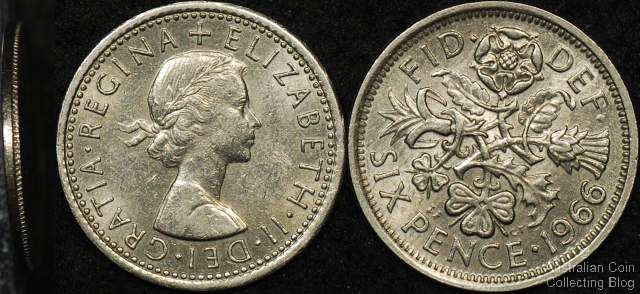
1966 Great Britain Sixpence with Straight Partial Collar Error
A partial collar coin error whether it be straight or tilted is a coin seen in many error coin collections. We've explained how this happens and is easily understood as the planchet having incorrectly seated in the dies when the coin was struck resulting in a skewed edge and partial milling. But have you thought further about why the planchet failed to sit properly in the first instance?
The answer to this question came in the form of a letter from the Royal Mint in London dated 1968 when Mr McMillan of Lanarkshire sent correspondence and an odd looking British sixpence to the Mint for examination. The coin proved to be a straight partial collar error and the documentation by JC Hill gives a suggestion as to it's occurence that we hadn't thought of before.
Prior to a coin blank being struck it is often fed through a rimming machine to be pre-rimmed before being struck into a coin. This process raises the edge of the coin and reduces the diameter of the planchet to allow for a reduced striking pressure (thus increasing the die life) and helps the coin wear better over the circulating life of the coin. Now if a coin blank missed this process of being rimmed it would therefore be more likely to not feed properly into the press resulting in an error just like a partial collar strike as it was just too large to fit correctly into the collar die.
Not all denominations of coins are pre-rimmed prior to the coins being struck. Is this why for some denominations you are much more likely to see this type of coin error? While on other denominations you just don't see with this type of error. This rimming process, or lack of it, is the likely reason for many of those partial collar errors in collector hands!
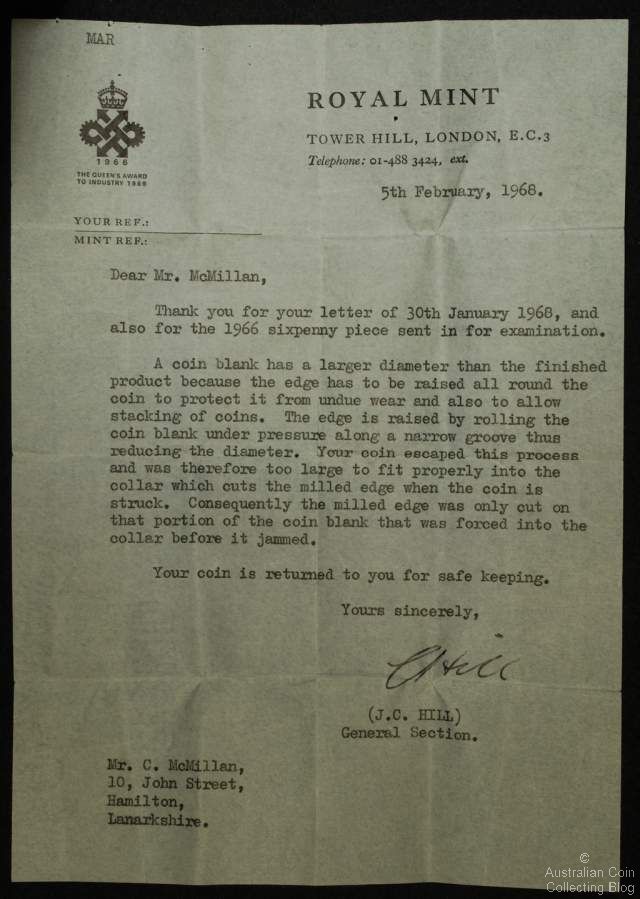
Royal Mint Letter Explanation of Error
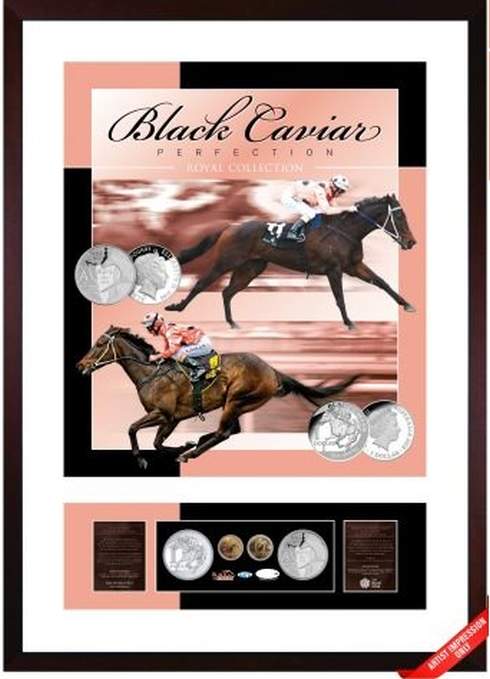
Australia 2013 Black Caviar Dollar in Silver included in the framed set
If you thought you had all the Black Caviar issues covered then think again. Limited mintages don't always mean the Mint can't strike more coins and issue them in different packaging! Someone is horsing around with us collectors!
In May 2013 the Royal Australian Mint issued a limited 2,500 1 oz fine silver proof Black Caviar coins which sold out in a flash. Followed closely by the same coin in a 2 coin set with a Cook Islands 1 dollar** struck by the Royal Mint also with a mintage of 2,500. The Mint's own website confirmed that 5,000 coins would be the complete mintage for this coin, a vital piece of information for collectors and investors.

Screenshot from www.ramint.gov.au suggesting a 5,000 total mintage
Now it appears a further 1,000 1oz fine silver coins* have been minted for a framed collection which includes the Cook Islands 1 dollar and the two aluminum bronze Australian coins retailing at $799 bringing the total mintage for this coin up to *6,000, not the 5,000 originally suggested to collectors. Coin collecting is a very expensive hobby!
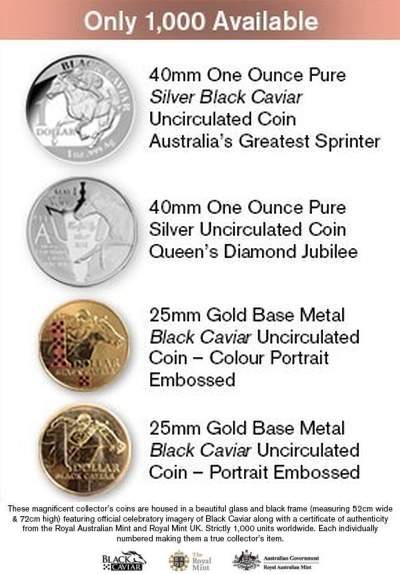
Coins included in the framed set
*Correspondence from the Royal Australian Mint says they haven't minted more coins - the Black Caviar licensing company have in used 1,000 of the single packaged coins to make up the framed sets. This means there are only 1,500 coins in the single coin boxed packaging and not 2,500 as previously thought. The complete mintage of the Black Caviar 1 oz silver proof is still 5,000 coins as the RAM states on the packaging.
**The Cook Islands 1 dollar minted and used in these Black Caviar sets depict a "fine racehorse" and aren't a specific depiction of Black Caviar. The coin commemorated the Queen's Jubilee year and her relationship with the Royal Ascot racecourse and the Gold Cup which was one of the races won by Black Caviar in 2012.
Collectors and investors at the top end of the rare coin and banknote market have been dealt another blow with the second major Australian numismatics dealer in the last year heading to the liquidators.
The Rare Coin Co. based in Western Australia have gone into receivership under the wing of Perth based Sheridans Chartered Accountants. The accounting firm will wind up the business and attempt to recoup money invested by many people who were investing for future returns for income or for their superannuation. Mum and Dad investors, business tycoons and Aussie farmers are among those seeking to sell rare coins and banknotes that were purchased in what appeared to be an artificially inflated marketplace. Now that certain sectors of the Australian coin and banknote market have seen drawbacks these investors are now seeing losses of many thousands or even tens of thousands of dollars. Changes to the rules governing self managed superannuation funds means that coins and banknotes (and other collectables) are now controlled more tightly and many investors have sought to sell off these types of assets. This is likely to be a contributing factor to the latest downfall in prices of banknotes in general and some collectable Australian coins.
Only 9 months ago in October 2012 administrators were appointed to John Pettit Rare Banknotes operating in Sydney. Strangely enough the John Pettit website still seems to be active. The rare banknote dealer reported losses of $2.4 million over 5 years but the exact magnitude of the loss and the point at which the business became insolvent were difficult to determine due to poor record keeping. It's interesting to note both companies now in crisis offered a buy-back guarantee on coin and banknotes sold to investors which it appears they could ultimately not fulfil.
Perhaps this is a warning to anyone looking to invest in coins and banknotes that they do their due diligence before investing under such guarantees. We do not offer investment advice on this blog and suggest if you are going to collect coins or banknotes then do so for the love of it. We have heard too many sad stories about investors who have lost money investing in coin and banknotes who knew little or nothing about the coins or banknotes they were purchasing. As always buyer (and investor) beware.
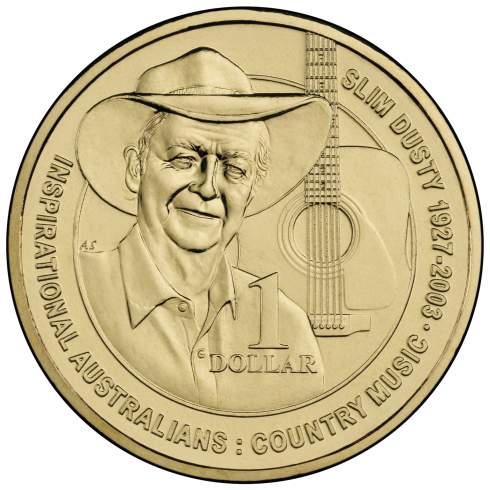
Slim Dusty Coin (image courtesy www.ramint.gov.au)
David Gordon Kirkpatrick AO, MBE is more affectionately known as Slim Dusty was a famed country music singer and songwriter for over 70 years. He is well known by this decimal changeover enthusiast as the singer of the song Decimal Currency Pub (well worth a nostalgic listen on youtube). Slims bush ballads and Aussie tunes span over 100 albums released selling over 7 million copies and were even broadcast from space on the 1981 Space Shuttle Columbia Mission.
2013 celebrates the 10th anniversary since the death of this King of Country and as such the Royal Australian Mint has released another 1 dollar coin in the inspirational Australians series honouring the achievements of unique and extraordinary Australians. Previously in this series we've seen Mary MacKillop (2008), Steve Irwin (2009), Fred Hollows (2010), Dame Joan Sutherland (2011) and Sir Douglas Mawson (2012) captured on a one dollar reverse. This Slim Dusty 1 dollar features a portrait of Slim next to his acoustic guitar (is it one of his 36 golden guitars awarded to him at the Tamworth Country Music awards) and designed by Aleksandra Stokic in collaboration with the Slim Dusty Foundation. The design includes Aleksandras initials AS.
This coin has the same characteristics as a dollar coin you find in your change but this design has been released for collectors (termed NCLT) only. Released in a collector card this uncirculated coin is produced in aluminium bronze and weighs 9 grams and is 25 millimetres in diameter. It has interrupted edge milling. The obverse or heads side features the standard Ian Rank-Broadley portrait of Queen Elizabeth II who celebrates 60 years since her coronation as Queen this year. Initially minted to collector demand the final mintages can be found in the 2013 issues and mintages page as they become available.
Issued for $13.50 proceeds of coin sales will go to the Slim Dusty Foundation helping to build the Slim Dusty Centre in his hometown of Kempsey NSW and develop scholarships to assist young Country Music artists.
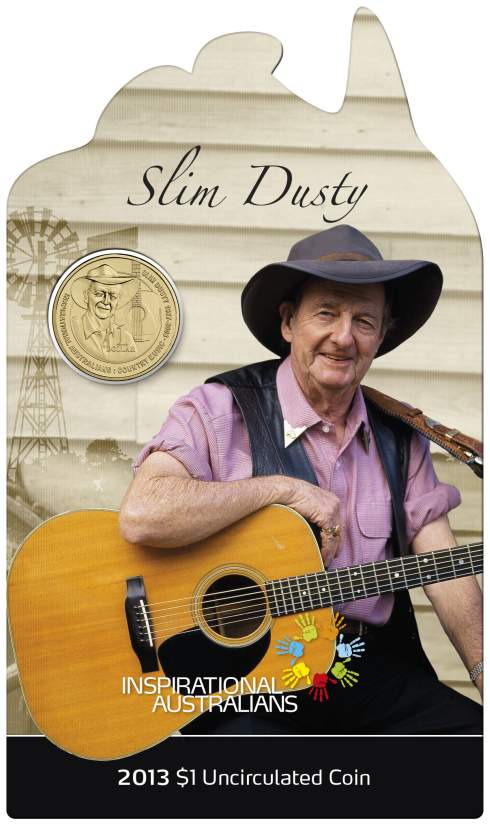
Slim Dusty Coin in Card(image courtesy www.ramint.gov.au)
Written by The Australian Coin Collecting Blog published in May 2013 Australasian Coin and Banknote Magazine.
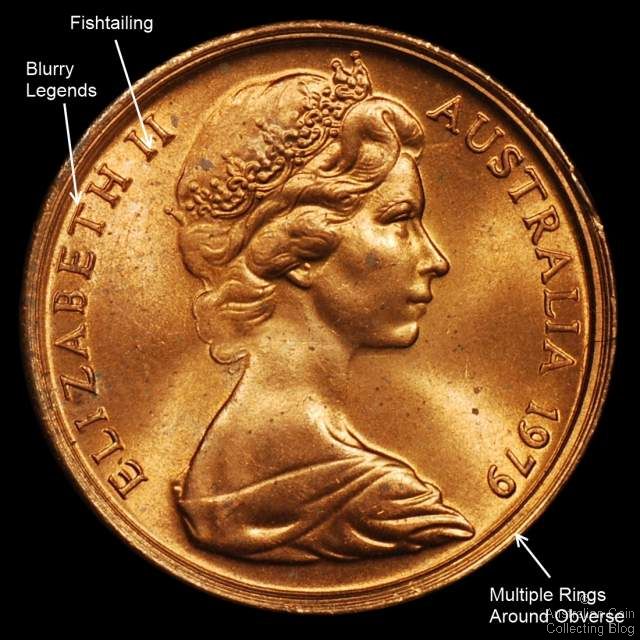
Figure 1
Discovered by a bank teller in the late 1970s and put aside as something unusual, the coin shown in Figures 1 and 2 is a superb high grade brilliant red 1979 2c piece. This coin was recently purchased from an antique dealer as a partial collar error but there's more here than meets the eye.
The coin edge (Figure 3) is where the most obvious deformity lies with a step in the edge showing where the collar was engaged and where it wasn't. As is typical for a partial collar error the side of the coin that was not engaged with the collar die at the time of striking has a slightly bigger diameter than the side of the coin that was. In this case the diameter of the obverse is larger because the flan spread outwards in this area when it was struck as it was not restrained by the collar. If you look closer at the edge of this coin it's apparent that there's more than one step, which suggests this coin is something more than a partial collar error.
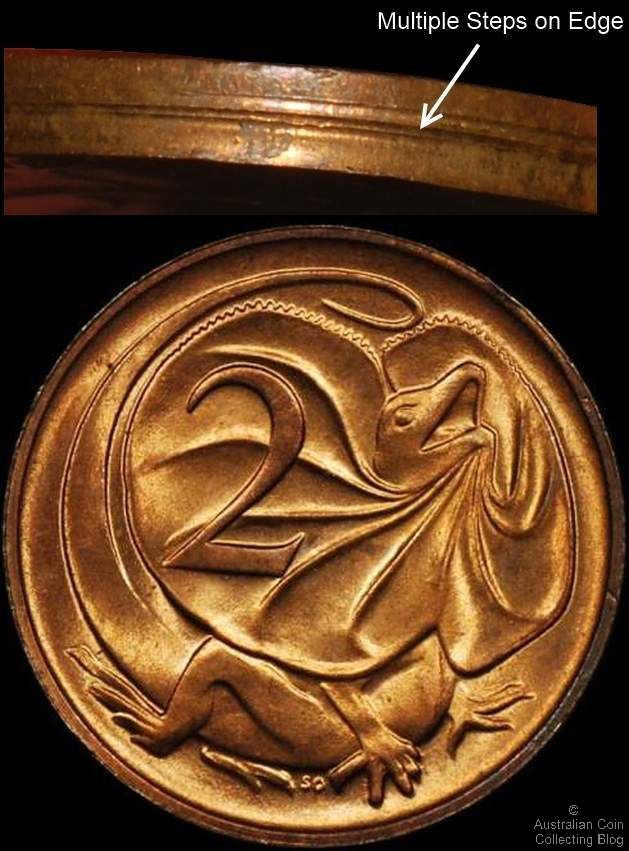
Figure 2 (bottom) and 3 (top)
Examination of the reverse of the coin (Figure 2) shows nothing of particular interest other than it being beautifully struck up. Even under a microscope there's nothing out of the ordinary to see. It's worth noting that the reverse of the coin (which was restrained by the collar) was struck by the anvil die or fixed bottom die. Close perusal of the obverse however paints a vastly different picture. Firstly, as shown in Figure 1 there are multiple rings near the rim around the obverse of the coin. Secondly, under a loupe some of the legends appear ever so slightly blurred and there's fishtailing evident on some of the letters.
It's not until we look at the obverse of the coin under a microscope that what's happened with this coin becomes more evident. Most of the obverse lettering shows evidence of radial metal flow or fishtailing. This is prominent in Figure 4 where the vertical stroke of the E has flowed outwards as indicated by the thinning of the horizontal strokes of the letter where they join the vertical stroke. Even more interestingly there's obvious proof that some of the letters have been struck more than once! Figure 5 shows the two II's of Elizabeth II have been struck multiple times. They also show radial metal flow with fishtails at the bottom of each letter. So what's going on here? The multiple steps on the coin edge suggest the coin has been struck a number of times, maybe up to 4 times. This is proven by the multiple rings around the obverse of the coin, the radial metal flow of the legends and clear visual evidence that the obverse legends have been
struck more than once.
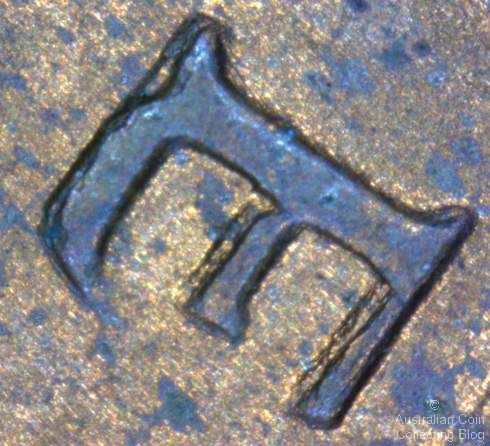
Figure 4
Here are our thoughts on how this interesting error coin came into existence. On the first strike, the coin only partially engaged with the collar and furthermore the coin must have jammed tightly in the press (collar). It was then struck again, and because it was jammed in the press so tightly there was no movement or rotation of the coin. With the obverse not being constrained by the collar the coin metal flowed outwards with each strike. The result of this is clear with obvious fishtailing, radial metal flow and multiple strikes as well as the rings near the rims.
The coin is a lovely grade, rescued by our helpful bank teller before entering circulation but the coin does have some rim damage. It's likely this occurred because the coin was jammed in the press which shut itself down in a fault condition and a minting technician used a tool to dislodge the coin and then restarted the press. Typically a multiple struck coin would appear more spectacular than this one, especially if it rotated or moved between strikes but we'll take this one as a fantastic new addition to our error collection.
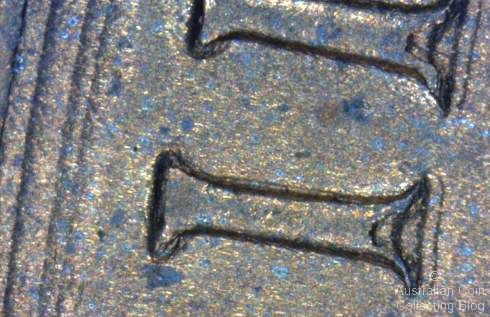
Figure 5
Acknowledgements
Thanks to Matthew Browne.
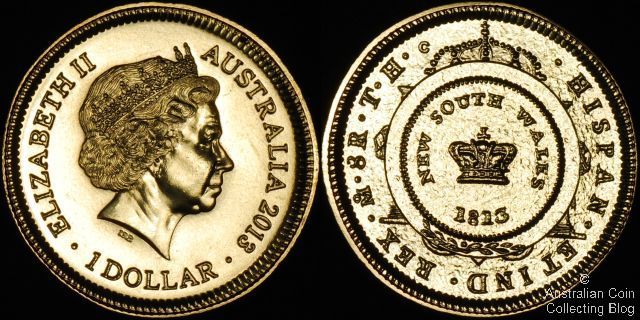
The Mintmark 1 Dollar for 2013, Bicentenary of the Holey dollar and Dump
| Year | Description | Type | Mint Mark | Composition | Notes | Mintage |
| 2013 | Mob of Roos | Circulation | None | AlBr | Circulation | *11,750,000 |
| Holey Dollar and Dump Bicentenary | Uncirculated | C mintmark | AlBr | RAM Gallery Press | * | |
| Holey Dollar and Dump Bicentenary | Uncirculated | C mintmark | AlBr | 4 coin unc set | *11,109 | |
| Holey Dollar and Dump Bicentenary | Uncirculated | S privymark | AlBr | 4 coin unc set | *11,109 | |
| Holey Dollar and Dump Bicentenary | Uncirculated | B privymark | AlBr | 4 coin unc set | *11,109 | |
| Holey Dollar and Dump Bicentenary | Uncirculated | M privymark | AlBr | 4 coin unc set | *11,109 | |
| Holey Dollar and Dump Bicentenary | Uncirculated | P Counterstamp | AlBr | mobile coin press, Perth ANDA Show | *5,017/5,000 | |
| Holey Dollar and Dump Bicentenary | Uncirculated | S Counterstamp | AlBr | mobile coin press, Sydney Royal Easter Show | *12,592/20,000 | |
| Holey Dollar and Dump Bicentenary | Uncirculated | B Counterstamp | AlBr | mobile coin press, Brisbane EKKA Show | *max 10,000 | |
| 200 Years of the Benevolent Society | Uncirculated | None | AlBr | Coin in Card | *16,002 | |
| Slim Dusty Inspirational Australians | Uncirculated | None | AlBr | Coin in Card | *12,602 | |
| Black Caviar | Frosted Unc | None | AlBr | Coloured coin in card | *15,278 | |
| Black Caviar | Frosted Unc | None | AlBr | Coloured coin in Framed Set | *500 | |
| Black Caviar | Uncirculated | None | AlBr | Non-Coloured coin in Framed Set | *500 | |
| Black Caviar | Uncirculated | None | AlBr | Non-coloured Coin in PNC | * | |
| Rockhopper Penguin | Frosted Unc | None | AlBr | Coloured Polar Series | *10,000 | |
| Polar Bear | Frosted Unc | None | AlBr | Coloured Polar Series | *10,000 | |
| Walrus | Frosted Unc | None | AlBr | Coloured Polar Series | *10,002 | |
| Weddell Seal | Frosted Unc | None | AlBr | Coloured Polar Series | *10,002 | |
| Atlantic Puffin | Frosted Unc | None | AlBr | Coloured Polar Series | *10,002 | |
| Humpback Whale | Frosted Unc | None | AlBr | Coloured Polar Series | *10,002 | |
| 40th Ann Sydney Opera House | Uncirculated | None | AlBr | Coin in Card | * | |
| 60th Ann. Korean War | Uncirculated | None | AlBr | Coin in Card | *13,102 | |
| AFL Premiers Hawthorn | Uncirculated | None | AlBr | Coin in Card | * | |
| AFL Premiers Hawthorn | Uncirculated | None | AlBr | PNC | * | |
| Year of the Snake Lunar Series | Uncirculated | None | AlBr | Coin in Card | *15,053 | |
| Australian Mining | Uncirculated | None | AlBr | 2 Coin Unc Set | *6,218/40,000 | |
| Australian Mining | Proof | None | AlBr | 2 Coin Proof Set | *6,218/25,000 | |
| Ethel C Pedley | Uncirculated | None | AlBr | Dot and the Kangaroo Baby Mint Set | *18,000 | |
| Mob of Roos | Uncirculated | None | AlBr | Mint Set | *42,450 | |
| Mob of Roos | Uncirculated | None | AlBr | World Money Fair Mint Set | *1,002 | |
| Mob of Roos | Proof | None | AlBr | Proof Set | *15,440/50,000 | |
| Mob of Roos | Proof | None | AlBr | Dot and the Kangaroo Baby Proof Set | *8,000 | |
| Mob of Roos | Proof | None | AlBr | Wedding Set | *500 |
| Year | Description | Type | Mint Mark | Composition | Notes | Mintage |
| 2013 | Holey Dollar and Dump Bicentenary | Proof | C mintmark | .999 Silver | Boxed Coin | *6,050/12,500 |
| Mob of Roos | Proof | None | .999 Silver | Boxed Coin | max 5,000 | |
| 60th Ann Korean War | Proof | None | .999 Silver | Boxed Coin | *3,300/5,000 | |
| Year of the Snake Lunar Series | Proof | None | .999 Silver | Boxed Coin | *4,200/10,000 | |
| Australian Decimal Effigies -Maklouf 1985 | Proof | None | .999 Silver | Legends Subscriber Exclusive | made to order, 310/max 5,000 | |
| Australian Decimal Effigies -Maklouf 1985 | Gem Uncirculated | None | .999 Silver | Legends Subscriber Exclusive | made to order, 330/max 5,000 |
| Year | Description | Type | Mint Mark | Composition | Notes | Mintage |
| 2013 | Mob of Roos | Proof | None | .999 Gold | Boxed Coin | max 500 |
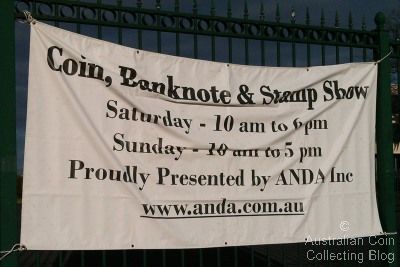
On Saturday the 6th of July 2013 we arrived at the venue for the 2013 ANDA Coin and Banknote Show in Melbourne after a short train ride from the Flinders Street station in the city to the Caulfield station. The show was held in the members enclosure at the Caulfield Racecourse as it has been for the last few years. The show this year was a little different because both of the major Australian mints, the Royal Australian Mint and the Perth Mint decided not to attend the show. As a consequence the queue at opening time was a little....small. See the image below for photographic evidence.
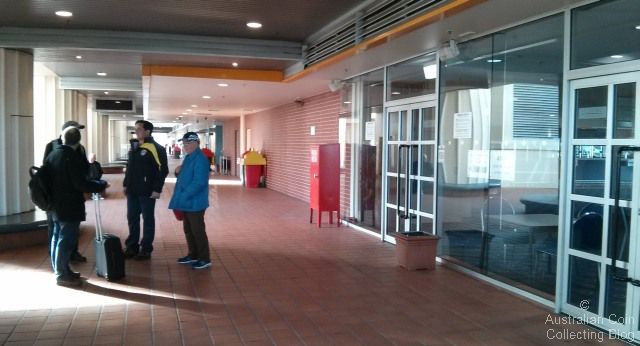
The Long Queue at Opening Time (NOT!)
As usual the door was attended by smiling members of the Numismatic Association of Victoria along with members of the Melbourne Numismatic Society and the Morwell Numismatic Society. Various members of these numismatic societies had an interesting set of displays in glass cases at one end of the room. The rest of the room (actually half the room) was taken up by the attending coin, banknote, and stamp dealers. Attendance at the show by dealers was quite poor and some of the dealers who did attend didn't bring as much material as we've seen them bring in the past. We believe there are a couple of reasons for this. Firstly, with the RAM and Perth Mint not at the show it was expected that attendance by the general public would be poor. Secondly, there's going to be another coin show in Melbourne in October (the Melbourne International Coin and Banknote Show) and perhaps dealers are planning on attending that in preference to this regular Melbourne ANDA show.
Kudos to the dealers that did attend. We saw the usual suspects, among these being Steele Waterman Coins, JPW Coins, Sterling & Currency, Prospect Stamps and Coins, Salamanca Rare Coins, Monetarium Adelaide, International Auction Galleries, Peter Strich, VP Coins, and Klaus Ford. John Eccles from Wellington, New Zealand made the trip across the pond as he usually does at this time of the year. Dealers we're not used to seeing attend shows included Pacific Rim Coins and Classy Collectables. There were a couple of dedicated banknote dealers in attendance (Trevor Wilkin and Tony James) and one stamp dealer (MPN Stamps). As usual the quality of material on display was excellent and we came away with several interesting purchases. Of note was the pile of inexpensive PCGS graded coins being sold by Chris Buesnell of Pacific Rim Coins. These were a great way of dipping your toe in the TPG coin market, with coins available at $28 each or 4 for $100. This is well below the current cost of getting a coin graded so there were bargains to be had.
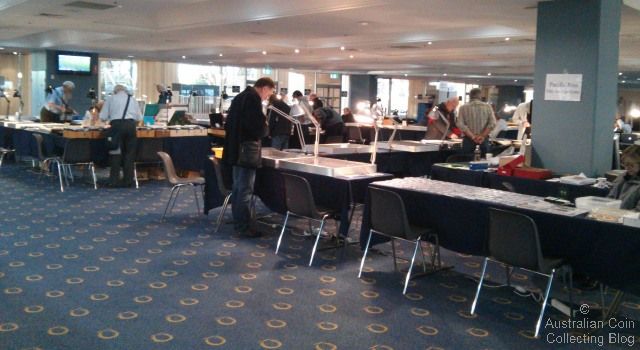
Some of the Dealers in Attendance
Despite the RAM and Perth Mint not having stands the number of people attending the show was pretty good from about 10.30AM through to 3PM or so. During this time it was a struggle to find folders of coins to look through and especially hard to find (and keep) a spot to sit at a dealer's table. We spoke to some dealers later in the afternoon and they reported a reasonable day of trade on both the buying and selling side of things. If you did attend the show you would have found a small canteen in operation where drinks, coffee, tea, and a light lunch was available. We partook of the coffee, a hot pie, and a sandwich and the quality of each far surpassed the rather dismal dinner we'd had in Melbourne's Chinatown the night before we attended the show.
We'd like to thank several people who were extremely hospitable during our trip to the ANDA show in Melbourne this year. Firstly, Darren, the president of the Numismatic Association of Victoria who looked after our suitcase during the show and made us feel very welcome the whole day. Secondly, our good friend Peter, who always makes our trips to Melbourne a pleasure (sorry for the bad Chinese on Friday night mate). And finally thanks to all the dealers who gave us time to talk to them, allowed us to go through their coin albums with a fine toothed comb and let us to what we enjoy most about the great hobby of coin collecting!


